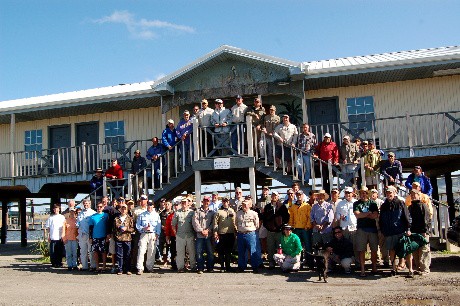Vibrio – The Summer Bummer!
Recently I’ve noticed multiple warning posts on social media sites about Vibrio Vulnificus, a naturally-occurring, necrotizing bacteria found in our Gulf coastal and inland saline/brackish waters.
These posts suggest things like “Be sure and keep Hydrogen Peroxide on your boat.” Of course, Mamma always cleaned our scrapes and cuts with it before applying a Band-aid, but back in 1987 the Journal of Family Practice published a study wherein they found that antibiotic ointments kill bacteria but Hydrogen Peroxide does not. (Just do a little Google homework if you doubt me.)
With that in mind, it’s best to leave the HP in the medicine cabinet and replace it with a 1:10 bleach and water solution in a plastic jug on your boat. When you get cut by a fin, pricked by a hook, or pinched by a crab, pour the solution straight onto the wound, dousing it thoroughly, letting it burn, baby burn!!!
Further, if you’re at the beach and have ANY sores on your body whatsoever, DO NOT GO INTO the water, especially if you have a compromised immune system. It’s just not worth the risk, as this bacteria is a deadly one, resulting in loss of life and limb every summer. If you do go into the salty water, take a bath afterward, adding a few caps full of chlorine bleach to your bathwater.
The social media warnings also list signs and symptoms of fever and red lines running up the arm. NOTE: This does not always occur. I did not have any red lines running up my arm from my Vibrio-infected finger. And I NEVER had fever. What I did have was a severely painful sore and a weird sensation of something creeping under the skin on my finger.
To show you again what happened to me in 2012 after cracking crabs for bait during a fishing trip, I am posting the photos showing the progression of what started the day after that fateful fishing trip as a tiny bump, similar to an ant-bite blister but much more painful, and ended up putting me in the hospital four days after the trip.
The below photos show Day 3 after cracking crabs, Day 4 at 9:30 a.m., and then 12 hours later at 9:30 p.m. on Day 4 in the Emergency Room.
My last sound bit of advice, based on my experience is this: If you’ve been exposed to brackish or saltwater and discover a very painful sore or blister anywhere on your person, DO NOT WAIT. Go straight to your doctor, tell them what you suspect, and ask them to culture the wound BEFORE you are given any antibiotic treatments. It is imperative that the wound be cultured in order to administer the correct medications. If they tell you it takes days to grow a culture, then insist they treat it as Vibrio Vulnificus in the meantime.
I tell you this from experience, because I started out at the doctor’s office (Photo 2) with an RX for oral antibiotics that DID NOT treat VV, even though I told the MD that I was 99% certain I had VV. I filled the prescription and went home with a false sense of security, which as I said, resulted in the bacteria continuing to eat my finger and landing me at the ER later that same night. The ER admitted me, hooked me up to two very strong IV antibiotics after a very painful debridement of my finger. (You will see from the third photo that those two doses of two broad spectrum antibiotics did nothing to slow the spreading.)
You know those PSA commercials on TV called “The more you know”?
Well, here you go, with the BW quote of the summer:
“The more you know about Vibrio, the better off you will be, yo!”
BW
PS: If you’ve landed here from a social media link, please leave a comment in the section below!
Comments, questions and conversations are welcomed and encouraged!!!









Wow. I had never heard of this
It’s quite common down here, and something I didn’t mention, is that anyone with a compromised immune system, having something like diabetes, should not even dare go swimming in the Gulf during the summer months through September!
You’re exactly right. Every fisherman I hear talking about this on our outdoor show on radio emphasizes the importance of keeping that Clorox solution on the boat. Some go to the extent of spraying themselves down with the same solution in the shower, and then doing the soap and water thing.
When it happens, it moves fast. The last time I fell in the water in the marina, I did the peroxide thing, and now know that I should have used Clorox. I didn’t get anything terrible, but there’s no question that I picked up something, because of the swelling, blisters, and general redness of my legs where I pile-drived into the mud.
Here’s another tip for people who live,play, or work around the water. Make a couple of index cards with all the pertinent information. Tack one on the refrigerator, and put one in your car. One in the boat wouldn’t hurt, either. That way, you don’t have to try and remember what to do, or what you may be dealing with, when time is of the essence.
Linda, I had forgotten your story about your pile driving episode! So glad it wasn’t more serious than that. There are other strains of vibrio and staph bacteria in the waters, which cause what your experienced and aren’t as bad as VV, but any infection can become serious if not treated as soon as possible. Your suggestion of a card in the boat with pertinent info. is a good one! thanks for thinking of that! How are the peepers?
A further note, from the CDC regarding the transmission o’ this nasty bug through food:
Persons who are immunocompromised, especially those with chronic liver disease, are at risk for V. vulnificus when they eat raw (or undercooked) seafood, particularly oysters. A recent study showed that people with these pre-existing medical conditions were 80 times more likely to develop V. vulnificus bloodstream infections than were healthy people. The bacterium is frequently isolated from oysters and other shellfish in warm coastal waters during the summer months. Since it is naturally found in warm marine waters, people with open wounds can be exposed to V. vulnificus through direct contact with seawater. There is no evidence for person-to-person transmission of V. vulnificus.
One of my sons’ have a small house in Bay St Louis and goes often.My grandsons just returned this past week from Bay St. Louis and stayed in the Gulf. I did not want them to go but they did!!!!!! Should know by now shouldn’t we? This scares me to death because I remembered how sick you were. Can I share this?
Your grandson will most likely be fine, if he is healthy and strong! I’m not trying to be an alarmist, but just warning those, like me, who might be targets for this sneaky bacteria! Absolutely please do share, as this is my intention!
Any idea how often the bleach should be replaced in the boat? I’m chemistry challenged, but I would imagine the heat would break down the chemical, and it should be replaced pretty often.
I don’t know how long it takes bleach to break down, but inside a plastic jug, in a dark storage compartment, it should last a long time. Maybe just refresh it at the beginning of each summer? That would make sense to me. I do know that bleach has a long shelf life, so it probably lasts a long time . . . but if you fish often and use it often, having it sit up for a long time isn’t an issue!!!!
Turns out you are right about heat breaking down the effective chemical component of chlorine bleach, Steffi, as pointed out to me via email including this attachment. I guess it will last about six months or so.
http://chemistry.about.com/b/2014/01/31/chlorine-bleach-shelf-life.htm
Mercy, I well remember your terrifying and painful experience. Thank you, from all of us, for the education. Keep well, sweetie!
We’re well, Cuz! It’s weird, though, that finger has been giving me trouble lately, almost three years after the event. Nothing lasting, though, just painful in the mornings until I get moving around, and then it’s fine! I did have a trip in June wherein I cracked crab for bait, and yes, I used my bare hands, but I cleaned them each time and was fine.
Dear BW,
I’ve just seen your story when I was doing a google search of Vibio wound infections. I work as a specialist on these bacteria in Europe.
You are very lucky. On average these wound infections carry a 20-25% mortality rate. In fact, the reason I think you are very lucky is that these infections can progress extremely quickly (often in 24 hours). Vibrios are amongst the fasting replicating bacteria in nature. Unfortunately I’ve reviewed a few of these cases that didn’t end so well. One thing I should point out is that these bacteria grow very well in lower salinity water, and don’t like salty water much (e.g. full strength seawater).
Craig
Hi Craig and thanks for the comment. These bacteria grow well in “brackish” waters which is exactly where I was fishing and also where the crabs came from that I was cracking for bait. Double whammy! I’d crack the crabs, then rinse my hands in the brackish water. All this about a week after a hurricane had stirred up all the waters and bacteria therein. If you’d like to email me, feel free by using any of the contact boxes on the site, and I’d be happy to further discuss my case. Yes, I am very fortunate to not have lost my finger, hand, arm, life. This was probably the most painful thing I’ve ever experienced in my life, including childbirth! We’ve had many cases in the area in which I live that did not end so well—either loss of limb and life. Thanks again! BW
Wow! Is my first time to see this article of danger.
Yep, nothing to fool around with in warm, Gulf waters!
Hi I had a little white blister appear on my finger yesterday we are in Crete and I was in the sea with my son only inshallow waters. This morning my finger after hurting through the night my finger has turned dark red and speckled and swollen at the end. I’m worried it could be this infection. Would you mind if I emailed you? Thanks in advance
Yes, Karen. I emailed you directly. I hope that by now you have sought medical attention. Good luck, and let me know what happens, PLEASE!